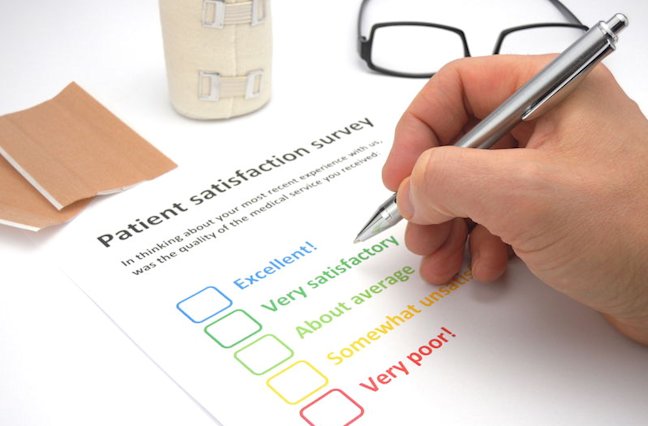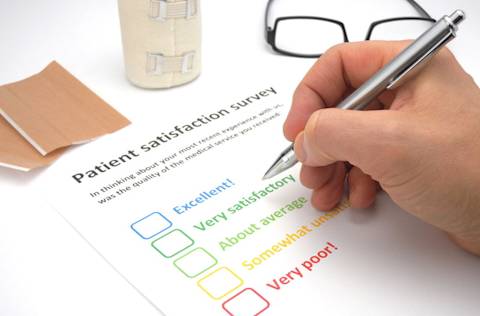CallMiner Product Innovation Series: Q1 2025
CallMiner's, Bruce McMahon, shares key product updates from Q1 2025. CallMiner AI Assist advancements, CallMiner Outreach, Bulk Export API enhancement...
CallMiner Outreach is here! |Learn about the future of CX

Solutions
Products
Customers
Solutions
Products
Customers
Resources
Company
August 28, 2019


In the United States, healthcare is a $3.5 trillion a year market and employs 1 in 8 Americans. For a market with huge impact and under tremendous scrutiny, you would expect medical organizations to take an interested, data-driven approach to measuring the patient experience (PX). In other words, you would expect their patient surveys to be relevant, well-written, and to the point.
You would also expect doctors’ offices, clinics, and hospitals to use multiple methods to gather a full range of insights about the quality of the patient experience.
From what I observe, when it comes to measuring patient experience in healthcare, good survey design is rare. And using mixed methods to uncover insights is rarer still.
Take for example a survey I received last week from Kaiser Permanente, one of the largest HMOs on the West Coast. I had a very short call with a doctor to get a referral. About a day later, I received a request to take a survey.
The request and the survey instructions were hard to scan quickly, the survey had typos, and it extended to 6 pages and 20 questions. In other words, taking the survey took more time than the referral call itself!
A poorly designed patient survey like this negatively impacts my perception of Kaiser but more importantly it shows they don’t understand patient experience research. Poorly designed surveys impact response and completion rates (sometimes resulting in biased samples). But these were not the biggest research problems with the Kaiser survey I received.
The biggest problem was that after 16 questions and a progress bar showing I was still only 75% done, Kaiser asked things they clearly knew the answer to, for instance, how long had I been a member?
Why in the world would they bother me for operations details they already have? Modern companies should streamline their customer feedback and link customer information to their surveys.
Ruth Brinkley, the president of Kaiser Foundation for the Northwest and Bernard J. Tyson, Kaiser’s CEO, ideally would require their survey company Press Ganey to integrate operations data into their surveys. But if there is a reason to keep their surveys clear of operations data for benchmarking reasons, they would be well served to incorporate other customer experience resources.
Kaiser is not the only medical organization that is bothering patients with bad surveys. One of my friends has stage 4 breast cancer. She told me that every time she has a test, check-up, or any kind of interaction, her highly-acclaimed oncology center in Florida bombards her with survey requests and reminders. On any number of levels, this is just plain wrong.
Should medical practices listen to their patients? Yes, they should and for one vital reason: the patient experience is often sub-par. Medical organizations are aware of this which is why they send so many surveys.
They know that if they were to succeed in patient listening—if they were to measure the right things in the right ways—they could steer their ship toward happier patients and families.
So, Kaiser is right for trying to listen but wrong for failing to take their survey program seriously.
Improving patient satisfaction has potentially significant benefits. Some research even shows that patient satisfaction impacts clinical outcomes.
Glenn Morley with BSM Consulting and I often discuss patient experience. Last month she shared a study from The Journal of Patient Experience with me. The study found a significant correlation between higher patient satisfaction ratings and lower hospital re-admissions.
This suggests that improving patient satisfaction isn’t just a nice thing to do, or the right thing to do, it may be the healthiest thing to do too!
Some sad facts: According to 2017 data from a national patient satisfaction survey, hospitals in the USA averaged scores of:
Responsiveness and communication are critical to succeeding with any interaction. So when you fail in these areas you can’t help but disappoint. But responsiveness and communication apply to more than the doctor’s interactions with patients.
There is much more to the patient experience than the direct medical interaction. I call it the everything else. Here are just a few examples of what that everything else includes:
Kellie Gordon of KinecticHealth shared this fascinating research with me. A recent study of patient complaints, 96% are related to customer service, while only 4% are about the quality of clinical care or misdiagnoses.
In the same study of nearly 35,000 online reviews of physicians nationwide, customer service was patients’ chief frustration, not physicians’ medical expertise and clinical skill.
When reviewing studies like this, keep in mind that patients may be loathe to criticize their doctor or nurse because they want something from them.
For instance, a patient might want to make sure their prescription is renewed without a fuss. Or, if they know they’re going to see that practitioner again, they don’t want to cause a rift in the relationship.
That said, frequently, more time is spent booking an appointment, sitting in the waiting room, picking up medication, and talking with support staff than is ever spent with the doctor. So it makes sense that patients complain more about everything else than they do their doctor.
The thing about these everything else touchpoints is that they’re not ‘surveyable’. Many of them are felt at a subconscious level so they aren’t easy things to ask about in a survey—and yet they still impact the patient experience. I often say, small things add up and small is not necessarily small.
How can medical providers measure, manage, and stay on top of the patient experience?
Mystery shopping, surveys, service evaluations, wait-room observations, and “ear-to-the-ground” feedback from staff all provide medical practices with a range of perspectives and data-driven insights.
Because the medical industry is enormous, if patient satisfaction were high, we might not only improve patient outcomes, we might raise the national optimism level as well! How will the medical industry get there?
Learn more about customer survey best practices at the September 19th webinar. Register today!
CallMiner is the global leader in AI-powered conversation intelligence to improve customer experience (CX). CallMiner delivers the industry’s most comprehensive platform to analyze omnichannel customer interactions at scale, combining deep domain expertise with cutting edge AI analytics and machine learning. By uncovering better intelligence, CallMiner enables companies to identify areas of opportunity to drive better experiences, ultimately leading to business improvement, growth and transformational change. CallMiner is trusted by the world’s leading organizations across all major verticals including technology, media and telecom (TMT), retail, manufacturing, financial services, healthcare, and travel and hospitality.